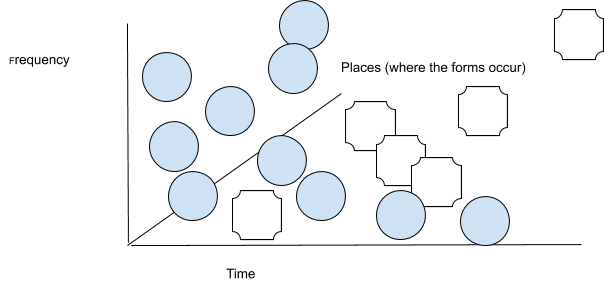Morphospace
https://docs.google.com/document/d/1dWnPD1fQti_K-cirb_v_r5b_u_6UmWxExrcyfRvDEO4/edit?usp=sharing
Research questions
How to express processes of development = of evolution in its wider terms, as a space? How to present even complex developments, presented in a formal way as changes in variables and their relations, as a changing spatial gestalt?
Background
Processes of development are either described qualitatively, or presented in algorithmic manners as equations, or parts of their constitutive elements (“variables”) visualized as simple graphs. This is not intuitive, and lacks any true visual evidence, i.e. an evidence showing the processes as a whole (→ gestalt), and not just in their parts.

A simple, abstract morphospace: 3-dimensional Cartesian morphospace with variations of 2 forms, blue (gothic) and white (Renaissance), with the 3 axes of frequency (y-axis) per place (z-axis), over time (x-axis).
Basic Concept
The idea of a morphological space or ‘morphospace’ relates to the basic one of how to express processes – and not only fixed, static structures – as gestalten of their own; and more specifically, it relates to Dynamic Flowcharts.
The constitutive procedure to create a morphospace is to align characteristics = “traits” to evolutionary processes, and to group those traits in their development in a 3dimensional space, to show (a), changes in their relationships towards each other and (b), to reveal different configurations over time = during that evol. Process.
References internal
A first hint gives the 2016 exhibition, the consecutive order of worlds presented (except the favela, of course) as an increasing degree in abstraction from the diversity of the real. That is, to depict an evol. process as an increasing degree of abstraction, expressed (manifested) in the order of appearance of the different worlds presented.
